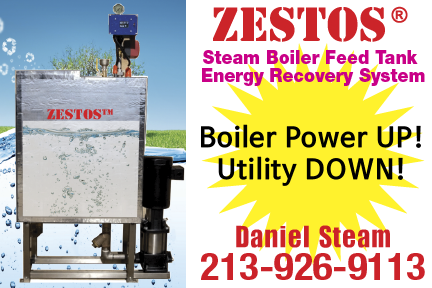In last month’s issue, I concluded the section dealing with the heating of solvent in the still, this month I’ll be explaining the other half of the distillation process, condensation.
SOLVENT VAPOR CONDENSATION
1. STILL CONDENSER
After the still has heated the liquid solvent sufficiently to vaporize, hot solvent vapor rises through a large diameter pipe called a riser into the still condenser. The still condenser is a cylindrical container enclosing a serpentine coil (think of the shape of a coiled snake) called the still condensing coil which has a cold liquid flowing through it, usually water or a water-glycol mixture. This liquid is called a coolant. The coolant reduces the temperature of the surface of the coil on which the hot solvent vapors condense (similar to water vapor condensing on a bathroom mirror). Problems in solvent condensation are usually noticed when there is an error condition alert linked to hot condensate. In the future, I will refer to condensate as condensate.
The performance of the still condenser is dependent on three parameters.
A. Pressure of the coolant being forced through the condenser coil.
B. The temperature of the coolant.
C. Heat transfer surface.
The following paragraphs will illustrate how these parameters may be used to troubleshoot problems incurred while distilling.
Common problems associated with the still condenser:
a. LOW COOLANT PRESSURE
Usually, there should be at least a 15 to 30 PSI difference between the inlet and outlet of the coolant across the still condenser. If this pressure is insufficient it may be indicated by the condensate and/or the coolant exiting the condenser coil being too hot, while the coolant inlet temperature is OK.
b. CLOGGED COOLANT STRAINER
On some machines, especially ones that have a separate coolant flow path to the still condenser, there is usually a strainer. If this becomes clogged the resultant problems will resemble problems with the water modulating valve described later in this article. Whenever you’re having a condensing problem it’s always wise to check all the liquid strainers on the machine.
c. INTERNAL SCALING
Over time, the liquid flowing through the still condensing coil may deposit a coating of scale. This scale reduces the flow of coolant through the coil as well as acting as an insulator reducing the ability of the condenser coil to transfer heat and cool the solvent vapors sufficiently. This condition will result in a smaller volume of condensate as well as reducing the ability of the solvent to separate from water which is also present along with the condensate (this condition will be discussed later in this article). Scaling can usually be identified by comparing the coolant inlet and outlet temperatures. There should be at least a few degrees difference between the two at the height of the distillation process. If the coolant exiting the condensing coil is actually hot it usually has to do with a faulty water modulating valve or clogged coolant strainer. Scale can usually be removed fairly easily by pumping a chemical through the coil, a process known as descaling.
d. INEFFICIENT OPERATION CAUSED BY HIGH COOLANT TEMPERATURE
If the coolant temperature is too high there will be a smaller volume of condensate as well as the condensate being much hotter. This reduces the ability of the solvent to separate from water which is also present along with the condensate (this condition will be discussed later in this article), thereby reducing the ability of the solvent to separate from the water resulting in high moisture content in the solvent. Warm coolant is easily diagnosed by measuring the temperature of coolant entering the still condenser and comparing it to the temperature specified by the machine manufacturer.
e. INEFFICIENT OPERATION CAUSED BY A FAULTY WATER MODULATING VALVE
On most distillation systems there is a temperature-controlled valve called the still condenser water modulating valve. This valve adjusts the flow of coolant through the still condenser coil to limit water usage when the DC machine is cooled by city water as well as a means to regulate the temperature of the condensate. It may be located on the inlet or outlet side of the still condenser’s coolant flow path depending on the machine manufacturer. The water modulating valve is designed to open wider as the temperature of the coolant rises, allowing more coolant to flow through the still condenser coil. If the condensate and/or the coolant exiting the condenser coil are too hot, yet the coolant inlet temperature is OK, it’s likely due to this valve or a clogged coolant strainer (before troubleshooting the water modulating valve check for a clogged coolant strainer).
f. CLOGGED STILL CONDENSER INLET or DEBRIS COATING THE OUTSIDE OF THE STILL CONDENSER COIL
In rare cases, especially after a still boil-over, debris may clog the outlet of the still riser pipe preventing solvent vapor from entering the still condenser. Symptoms of this rare problem are a marked decrease in distillation rate with condenser coolant inlet temperature being normal with no temperature difference between the coil inlet and outlet temperatures. If the clog is great enough it will cause the still pressure relief valve to open and solvent vapor and condensate will be apparent on the outside of the still around the valve. Still boilovers can also result in coating the still condenser coils with debris. This will prevent a heat transfer from the solvent vapor to the coil surface resulting in poor distillation. Clearing this clog or cleaning the coil will usually require disassembly of the condenser housing.
Well, that’s it for this issue. I’ll be continuing with the safety devices used in the still condensation system in the next issue.

Bruce Grossman
Bruce Grossman is the Chief of R&D for EZtimers Manufacturing. EZtimers is the manufacturer of the new EZ DOSE boiler compound manager and return tank level control which replaces that troublesome ball float valve in the condensate return tank and automatically adds the correct amount of boiler compound to the return tank preventing the oxygen corrosion and scaling. Our SAHARA and DIB-M high purity separator water mister/evaporators provide a thrifty, legal method to get rid of the separator water generated by your dry-cleaning machine. See our Ad in this issue and for further information on EZtimers products visit www.eztimers.com Please address any questions or comments for Bruce to bruce@eztimers.com or call 702-376-6693.

